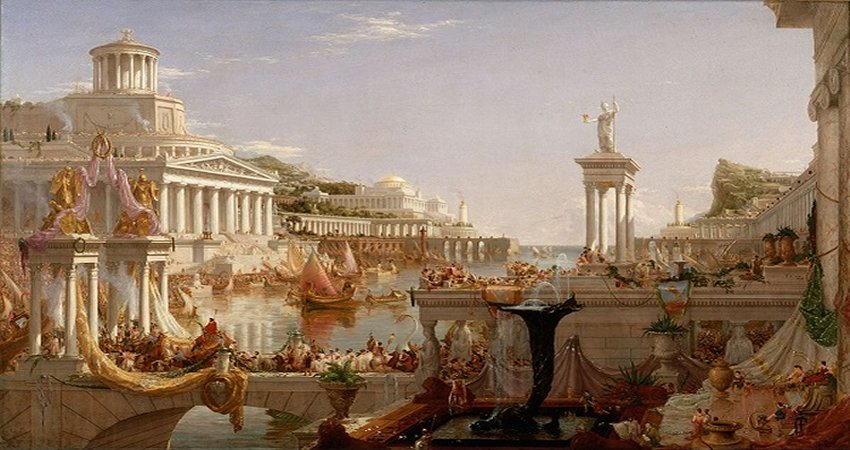Jan Bartek – MessageToEagle.com – Climate change is a natural process and it affects all living beings, but how much must temperatures change for a powerful ancient civilization to fall?
According to a new study, the fall of the Roman Empire coincided with the warmest period of the last 2,000 years in the Mediterranean. Researchers have been able to confirm the Mediterranean Sea was 3.6°F (2°C) hotter during the Roman Empire than other average temperatures at the time.
The climate conditions derived progressively towards arid conditions and later colder ones coinciding with the historical fall of the Roman Empire founded by Octavius Augustus in 27 BC.

A climate transition from wet to arid conditions could have market its following decline. Image: The consummation of the empire, Thomes Cole (1836)
The fall of the Roman Empire is one of the most interesting events in the history of Europe. The mighty Empire lasted for over 1000 years. During that time Rome grew to rule much of Europe, Western Asia, and Northern Africa.
The Romans naturally had their share of enemies, and the Empire was constantly attacked by major Barbarian tribes such as the Huns, Franks, Vandals, Saxons, and Visigoths (Goths).

Rome was sacked seven times, but each time, Rome rose again. However, nothing lasts forever, and eventually, the Empire fell.
In 476 C.E. Romulus, the last of the Roman emperors in the west, was overthrown by the Germanic leader Odoacer, who became the first Barbarian to rule in Rome.
According to a group of scientists from the University of Barcelona, climate change did play a vital role in the decline of the Roman Empire.
Previous studies had related the fall of the Roman Empire to some natural factors (climate change, volcanic eruptions, etc.). With a large-scale regional view, the study provides high resolution and precision data on how the temperatures evolved over the last 2,000 years in the Mediterranean area.
“For the first time, we can state the Roman period was the warmest period of time of the last 2,000 years, and these conditions lasted for 500 years”, notes Isabel Cacho, professor at the Department of Earth and Ocean Dynamics of the UB.
The Mediterranean Sea is a semi-closed sea –extremely vulnerable to modern and past climate changes–, with a strategic location. Home to many civilizations over the years –with a tradition for historical and archaeological studies–, Mare Nostrum is a model to study the periods of climate variation and climate potential influence in civilizations.
In particular, the Roman Empire period is hard to study, “since it coincided with important cultural changes that took place around the Mediterranean. The study of the climate of the past is now the only tool to analyze the dynamics of the climate System of the Earth in different conditions from the current ones, and it is essential to test the validity of the mid and long term prediction models”, note the experts Giulia Margaritelli (also member of the CNR-IRPI) and Fabrizio Lirer (CNR-ISMAR).
The study identifies the Roman period (1-500 AC) as the warmest period of the last 2,000 years. Map A shows the central-western Mediterranean Sea. Red triangle shows the location of the sample studied, while the red circles are previously-found marine records used for the comparison. Map B shows the Sicily Channel featuring surface oceanographic circulation and sample location. Black lines follow the path of surface water circulation.
The study identifies for the first time a warming phase which is different during the Roman period in the Mediterranean area and is focused on the reconstruction of the sea surface temperature (SST) over the last 5,000 years.
These new records were correlated to data from other areas of the Mediterranean (Alboran Sea, Menorca basin and Aegean Sea) to show a regional signal of the basin to identify the Roman period (1-500 AC) as the warmest period of the last 2,000 years, 2ºC warmer than the average values at the end of the century. Experts say the impact of the rainfall regime during this period –marked by a great regional variation of the most wet and arid phases- in the evolution of the Roman Empire.
See also: More Archaeology News
Scientists point out this phase coincides with the development of the expansion of the Roman Empire, which suggests a potential relation between favoring climate conditions and the change into the great empire founded by Octavius Augustus in 27 BC.
According to the hypotheses of the authors, a climate transition from wet to arid conditions could have market its following decline.
Written by Jan Bartek – MessageToEagle.com – AncientPages.com Staff Writer







